Martina Bienenfeld: Zagreb will Become a Desirable Digital Nomad Destination
21 June 2021 – The Zagreb Tourist Board (TZGZ) organises the first-ever Zagreb Digital Nomad Week from the 21st to 27th of June after which the project called Zagreb Digital Nomad Ambassador will start. The latter will enable selected digital nomads to spend a month in Zagreb for free and share their experiences. A closer look at why Zagreb is a desirable digital nomad destination.
As translated from Seebiz.e, Zagreb Digital Nomad Week 2021 and the Digital Nomad Ambassador project TZGZ is organising together with Saltwater Nomads (a company specialising in organising digital nomads' stays in Croatia) and Total Croatia News (media portal).
It is these programs focusing on digital nomads that were the motivation for our conversation with Martina Bienenfeld, the head of the Zagreb Tourist Board.
SEEbiz: what was the main motivation behind deciding for the Zagreb Digital Nomad Ambassador program?
Bienenfeld: Last year changed the way of life for many people. The pandemic, which made working from home common, accelerated the trend of digital nomads and we now have generations of employees that are no longer bound by working hours, but wish to enjoy a more flexible way of life. Also, at the beginning of this year, the new Law on Foreign Nationals came into power. Under it, digital nomads can be allowed to stay in Croatia for up to a year on a non-resident basis. Zagreb, being the capital city, didn't want to miss out on this growing opportunity, so we've decided to organise Zagreb Digital Nomad Week and the Zagreb Digital Nomad Ambassador project.
SEEbiz: it is no secret many fast-expanding IT companies have their headquarters in Zagreb. Is this one of the reasons Zagreb is perceived as a destination for digital nomads? What are the prerequisites Zagreb needs to fulfil to become an attractive and desirable destination for this demographic?
Bienenfeld: That certainly is one of the reasons, but there are numerous factors that influence the choice of a destination. Above all, digital nomads are staying within one place as long as they can and want, and because they are working they value quick and reliable internet connection more than anything, which means the destination needs to have good quality telecommunication infrastructure. After that, they need good value for money and accessibility of co-working spaces. Nice weather is also high on the list. Also, proximity or at least easy accessibility of the destination is one of the conditions. Zagreb offers all these things. In this sense, the level of attractiveness of Zagreb is high and I believe there is potential to grow further, especially seeing how we are one of the first countries to regulate this type of work by law.
SEEbiz: Do you believe digital nomads are just a trend that is, among other things, here because of a global pandemic or is it something that will remain after this situation has subsided?
Bienenfeld: Assessments and research suggest more and more people will want to work independently like this in the future. In other words, they will want the freedom to travel and the ability to work where ever they are at any given time. Therefore, I believe this is not a passing trend, but a new style of working and living that will remain long after this situation.
SEEbiz: The Croatian Tourist Board (HTZ) digital nomads campaign “Croatia, your new office!” garnered great results in the first two months. What are you expecting from the projects taking place in Zagreb?
Bienenfeld: I’m expecting Zagreb to further improve its position as a desirable destination for digital nomads. Croatia’s capital can surely be positioned as a centre for digital nomads and draw in foreigners coming for work and leisure.
SEEbiz: Zagreb has been recognised as a city break destination. In spite of all the restrictions, Zagreb was a good host for Croatia Rally, and then there is also the World Rowing Cup. Is sport, professional or recreational, one of the ways of attracting digital nomads?
Bienenfeld: As I mentioned before – you always need a combination of different factors in order to attract digital nomads. Generally, when speaking of sporting events, we have to be aware they are one of the most important ambassadors of any country or the city in which they are being held. We at TZGZ are especially pleased Zagreb hosted such huge sporting events – World Rally Championship and World Rowing Cup – during these times of uncertainty. This points to the significance of our city in the segment of sports tourism as a special part of the travel industry which contributes to the creation of new quality and competitive position in the travel market. Namely, events like these cast a spotlight on the host destination and make organisers of other similar events across the world consider organising their future events in the same city or country. In the same way, the effects of such a synergy of sports and tourism add to the popularity of the destination hosting these events and represent one of the best ways of promoting Zagreb as well as Croatia.
SEEbiz: Zagreb Tourist Board saw a focus on developing new digital platforms proving successful. How do you view the importance of digitalisation in tourism?
Bienenfeld: Tourist Boards always kept pace with new technological trends and implemented them readily into their projects. We need only remember Zagreb Be There app developed in now distant 2014, which was a multiple award-winning treasure hunt sightseeing app, or QR code city tour implemented in 2013. The pandemic and, unfortunately, Zagreb earthquakes, taught us the importance of being able to respond well and quickly to new situations, follow trends by using digital tools and platforms, and adjust our tourism offer to new conditions. We have turned to digital innovations that allow us to add value, attractiveness, but also visibility to our tourism offer. A recent example is the interactive AR project Virtual Christmas Windows, in which we were first in Croatia to apply augmented reality technology in our Christmas festival awareness campaign. Digitalisation in tourism is imperative today. Tourism and technology are tightly intertwined and travel is unthinkable without digital technology.
SEEbiz: The Around Zagreb project and cooperation of the Zagreb Tourist Board and Zagreb County Tourist Board is one of the first big steps in strategic destination development in Croatia because the focus is on quality content and finding new benefits for tourists, seeing how it promotes quality tourist-focused content in Zagreb’s surroundings or only half an hour from the city centre. Zagreb and its surroundings as a unique green destination, is this the strategy for the post-pandemic period?
Bienenfeld: I’m glad you’ve asked me that as we are just starting with our refreshed campaign in cooperation with the Zagreb County Tourist Board, and soon we will go ahead with Krapina – Zagorje County as well. Project Blizu grada, blizu srca (Close to the City, close to Heart) / Around Zagreb is created with a long-term goal and vision and we would like to have started it even without the pandemic situation. It is natural for Zagreb and its surrounding area to promote together because guests do not care about our administrative borders. They are after quality and interesting content. The pandemic in a sense helped the campaign along because guests are now, more than ever, searching for the options of spending time in nature, on fresh air, surrounded by greenery, all combined with diverse local culture and gastronomic offer.
Last year, most of the visitors to www.aroundzagreb.hr came from Croatia (40%), but also from the markets where the campaign was run – Slovenia (35%), Austria, Germany, and Bosnia and Herzegovina (25%). Interestingly, we are seeing a rising interest from the American market as well, even though there was no advertising campaign specifically aiming at that market, which represents a guideline for future activities. Inspired by the success of the campaign so far, recording over 37 million views, we have improved our platform and are showing it to the important markets again. With this in mind, along with refreshed visuals and itineraries, we have started a new section called “Did You Know?” which showcases various interesting points from our surrounding areas. Besides that, we also have cooking videos featuring authentic local cuisine recipes from Zagreb and the surrounding area. They are made by the famous Croatian chef Mr. Almo Catlak. He set out to present local delicacies to a wide audience with an emphasis on tradition with a bit of a modern approach. We are now starting the campaign for the markets of Austria, Bosnia and Herzegovina, Slovenia, Serbia, and Germany and soon we will be updating it with Krapina – Zagorje County materials. I would hereby also like to give my thanks to all involved in this.
SEEbiz: Zagreb is also an airplane destination. What effects do you expect as a result of RyanAir coming to Zagreb Airport, or how important in this respect is the survival of the national airline company?
Bienenfeld: We welcome all new airlines coming to Zagreb and will be glad to see the RyanAir airplane “tales” among those of other companies already landing in our city. This will contribute to the further positioning of Zagreb as a city break destination and will make it more accessible to interested visitors. As far as the national carrier is concerned, we mustn’t forget it was Croatia Airlines that connected us to the rest of the world when all other companies stopped flying here during the toughest pandemic restrictions. In this sense, I wouldn’t compare these two airline companies because their profiles and business models are vastly different.
SEEbiz: We know we are living in very uncertain times, but at the end of the interview, let me ask you: What is your vision for the long-term tourism development of Zagreb.
Bienenfeld: We need to keep in mind it will take a few years after the pandemic for tourism to bounce back. The earthquake made things even more difficult because it damaged a variety of buildings, some of which contribute to tourist offers or architectural and urban distinctions of the city. The state of tourism will depend on the organisation and readiness of the destination to adapt to new conditions and provide solutions. Further development of tourism in a smart, responsible and sustainable way will depend on how much are we as a sector prepared for new challenges. From the perspective of tourism, it is clear more and more travellers take into account ecology and sustainability, and we, therefore, need to apply sustainable concepts in order to potentially make them into one of the key promotional factors.
Also, it is important to activate underused tourist resources and continue to develop key tourist products of the destination. With the goal of defining a stronger position in the travel market in this context, it is necessary to support innovative and creative development initiatives that contribute to further building of the destination as a centre for urban, regenerative, and cultural scene and encourage dispersion of tourist activities. For the MICE segment we are expecting a slower recovery, but we need to continue communicating with the organisers of conferences and events and position Zagreb as a regional centre for business meetings, gatherings, and conferences. I see additional potential in health tourism, sports and active tourism, and of course food tourism. In any case, what is important and we’ll continue to insist on is that Zagreb is and always was a people’s city.
For more on Digital Nomads in Croatia, click here
Energy Institute Hrvoje Požar (EIHP) to be First Nearly Zero Energy Building in Croatia
June 21, 2021 - An exciting new step for Croatian energy efficiency is happening at the Energy Institute Hrvoje Požar (EIHP), as the Institute makes significant changes to its building which will also help to educate other experts for energy efficiency.
As the Energy Institute Hrvoje Požar (EIHP) gave great support and input in REPLACE Project that brings energy efficiency to Rijeka and Kvarner region, just put a new log in Croatian energetic efficiency. The start of June saw the contract for granting non-returnable funds for founding nZEB- the National Training Center on Nearly Zero Energy Buildings, EIHP reported on its website. The project is financed from the „Energy and Climate Change“ Fund, part of the Financial Mechanisms 2014 – 2021 in Croatia, courtesy of the European Economic Area (EEA).
1,600,000 Euros is the total value of this project on which EIHP collaborates with the Faculty of Civil Engineering, University of Zagreb. The goal is to empower all the actors in reconstructing buildings to meet the nZEB standard.
With the center being established in the building of the Požar Institute undergoing reconstruction at the moment, it will be a vivid example of the modern technologies that are implemented in nZEB design.
„We will show and share with the widest professional community the solutions that will be developed through this project. The whole process of reconstruction will be followed and documented, and detailed, and serve as an example in the training program as the Institute becomes the first public building in Croatia reconstructed in such a manner. With the appliance of green energy technologies (electrification of heating and cooling systems with a crane that uses shallow geothermal source, integrated photo charged electric plant on the roof, energy containers, efficient lighting), we also wish to include E-mobility, which is certainly the future of traffic as well as accomplish complete digitalization of all technical systems the building is using. That way, the building will be the showcase example of the double transition – green and digital“; said the EIHP headmaster, Dražen Jakšić.
Jakšić attended the signing of the contract, along with the regional development Minister Nataša Tramišak, Norwegian Ambassador Haakon Blankenburg (as Norway also supports the Financial Mechanisms 2014 – 2021), Ministry secretary of economy and sustainable growth dr. Mario šiljeg, and the Faculty of Civil Engineering dean dr. Stjepan Lakušić.
„After this pandemic, we will not develop by repeating the things from before. A historical change is afoot, and we will meet it with green development and with new 'Green Deal'“, concluded Jakšić while Minister Tramišak also pointed out that securing financial mechanisms for advanced technologies and energy renewal.
Learn more about Croatian inventions & discoveries: from Tesla to Rimac on our TC page.
For more about science in Croatia, follow TCN's dedicated page.
State Officials Visit Divulje Airbase Ahead Of Wildfire Season
June 21st, 2021 - Representatives of the government, firefighters, and army on Monday said at the Divulje airbase that they had seen that firefighters and the system were prepared for the wildfire season ahead.
Defence Minister Mario Banožić, Interior Minister Davor Božinović, Firefighter Chief Commander Slavko Tucaković and the Chief-of-Staff of the Croatian Armed Forces, Robert Hranj, visited the Operational Fire Command at Divulje.
They said that all the necessary steps have been taken for preparedness for the coming wildfire season but called on citizens and tourists to alert and immediately report any fires erupting.
We have seen that the Operational Fire Command is prepared for the coming season, said Defence Minister Banožić.
He said that the Croatian Amy had prepared land, sea, and air forces for the fire-fighting season.
Six Canadair planes available, one damaged.
Banožić said that six Canadair planes are available, in addition to six Air Tractors and one helicopter. The Armed Forces will ensure up to 200 soldiers on stand-by for emergency interventions and two landing boats and two rubber dinghies.
He added two Canadair planes and one Air Tractor were currently having a technical inspection while a bird damaged one Canadair plane.
Interior Minister Božinović underscored that the government would continue equipping emergency services, including firefighters. He recalled that the second-last shipment of state-of-the-art firefighting vehicles was delivered last week and that the last shipment of 94 vehicles will arrive ahead of the tourist season.
Croatia has received funds to maintain two Canadair planes
Božinović said that the European Commission had just announced that Croatia had been approved €1.8 million to maintain two Canadair planes that will be part of a joint European force, prepared to assist with forest fires across borders.
He added that Croatia would continue to absorb funds from the EU, saying Croatia has been recognized as a responsible partner worth investing in at the EU level.
Firefighting Chief Tucaković said that this year the system would be connected with 96 cameras that will transmit information about wildfires to the Divulje Operational Fire Command. Drones will also be engaged in that task, he said.
"We are in the process of employing 1,172 firefighters in seven coastal counties, which will contribute to improving the entire firefighting system to react faster to wildfires," said Tucaković.
For more, follow TCN's dedicated page.
This Year European Firefighting Fleet Comprises 11 Planes, 6 Helicopters
June 21st, 2021 - The European firefighting fleet will consist of 11 firefighting planes, including two from Croatia, and six helicopters, for this year's wildfire season, the European Commission said on Monday.
The rescEU firefighting fleet will consist of two firefighting airplanes from Croatia, two from Greece, two from Italy, two from Spain, and six firefighting helicopters from Sweden. This comes in addition to one firefighting airplane from France and two from Sweden, which is part of the rescEU fleet on a long-term basis.
"Ahead of this year's forest fire season, we must do all that is necessary to reduce the impact of fires. Therefore, our proposed rescEU firefighting fleet will include 11 planes and 6 helicopters and can be readily deployed any time during this forest fire season," said Commissioner for Crisis Management Janez Lenarčič.
The season's risk for forest fires is forecasted to be above average, with temperatures expected to be higher-than-average from June to September in the Mediterranean region, the Commission said. The season might also see less rainfall, especially in central Europe and many areas of the Mediterranean, it added.
For more, follow TCN's dedicated page.
Zagreb Digital Nomad Week 2021 Opens at Canopy by Hilton
June 21, 2021 - A strong lineup of Zagreb officials opens Zagreb Digital Nomad Week at Canopy by Hilton.
Tourism is changing, and new opportunities are presenting themselves, just as more tradiional mass tourism seem to be a thing of the past.
The pandemic has helped accelerate the previous trend towards remote work, with an oft-quoted pre-pandemic figure of one billion remote workers globally by 2035, a number which now sounds conservative.
Croatia has been one of the more high-profile countries in the world over the last year with its efforts to introduce the digital nomad permit, which came into effect on January 1, 2021.
The number of applicants is increasingly steadily, but the bigger PR message gained both from the visa push (only Estonia in Europe had a digital nomad visa when Croatia's was announced last summer), coupled with Croatia's more relaxed stance on allowing travellers to come in, and its position as an EU country outside the Schengen zone, has attracted a steady number of digital nomads over the last year.
Saltwater Nomads, in cooperation with TCN, the City of Dubrovnik and the Dubrovnik Tourist Board organised the first-ever digital nomad conference in Croatia last October, followed by the world's first digital nomad-in-residence program in Dubrovnik which ended last month.

The focus has now shifted to the Croatian capital, where Zagreb Digital Nomad Week 2021 & Zagreb Digital Nomad Ambassador Project kicked off this morning at Canopy by Hilton, one of 7 locations over 7 days, exploring 7 DN-related themes.
The project is a collaboration between Saltwater Nomads, TCN, Doma Zagreb, the Digital Nomad Association Croatia, and the Zagreb Tourist Board (funded by the latter), and there was a high-profile turn out from city and national officials to open the conference.

After the opening welcome from Saltwater Nomads CEO Tanja Polegubic, State Secretary for Tourism and Sport, Sandra Herman, was next to speak. Herman pointed out the support the Ministry has given to the push for the digital nomad permit, a collaboration between various ministries, and Dutch entrepreneur Jan de Jong, whose open letter to Prime Minister Andrej Plenkovic on LinkedIn last July started the permit initiative.

The new Mayor of Zagreb, Tomislav Tomasevic, was represented by Ivo Spigel, one of the founders of the Mozemo platform working with the new city administration. Spigel pointed out the excellence of the Croatian startup scene and plans for digitalisation. A younger and more forward-thinking city administration seems keen to engage with the new opportunity of remote work for Zagreb.

Martina Bienenfled, CEO of the Zagreb Tourist Board, voiced her strong support for the digital nomad initiative, seeing it as a great opportunity for Zagreb tourism to develop in a new direction. A safe, affordable European capital, with enviable lifestyle, great gourmet options, activities and nature in and around the city,, with great connectivity and English widely spoken are just some of the competitive advantages.

The 7 days will each focus on an individual theme - cybersecurty, online presence, remote careers, tax & finance, the future of work, wellbeing, and explore Zagreb. The keynote speakers are a mixture of in person and remote speakers. Mandy Fransz of Make the Leap Digital, flew in from the Netherlands, and she will have her keynote speech on Oline Presence tomorrow at 09:00 at BIZkoshnica Coworking, tomorrow's host.

Day 1 focused on the theme of cybersecurity, with Marko Rakar - recognised by the World eGovernment forum as one of the “Top 10 who are changing the world of politics on the internet” - as the keynote speaker. Rakar gaven an entertaining and thought-provoking presentation, which had everyone in the room a little more concerned about their online security. You can read Rakar's pre-conference TCN interview here.

And no digital nomad conference would be complete without its own mascot, and Miso the dog made his presence felt during the opening speeches.
Each evening this week includes a networking Happy Hour, followed by a themed tour of the city by local specialists, Secret Zagreb.
The rest of the programme is available online on the Saltwater Nomads website, and each session is livestreamed. Registration is free, both online and in person, and you can see the rest of the program and register here.

Meet Friday's keynote speaker, Albert Cañigueral, one of the Dubrovnik nomads-in-residence, and recently appointed to lead the Catalan Government's Transparency and Open Data division. Albert will be focusing on the topic of the day, the future of work.
Meet tomorrow's host - BIZkoshnica, Zagreb Coworking Since 2015: Mirela Marovic Omerzu Interview.
Tourist Board Director Martina Bienenfeld on Zagreb Digital Nomad Week, Ryanair, Tourism in Pandemic
For the latest news and features od digital nomads in Croatia, check out the dedicated TCN section.
Dalić and Perišić Talk Croatia ahead of Scotland, Billy Gilmour Positive COVID-19 Result
June 21, 2021 - Coach Zlatko Dalić and vice-captain Ivan Perišić addressed the press to speak about Croatia ahead of Scotland on Tuesday.
The Croatia national football team coach Zlatko Dalić and vice-captain Ivan Perišić addressed the press the day before the decisive match for a spot in the EURO 2020 round of 16.
After losing to England (0:1) and drawing to the Czech Republic (1:1), Croatia will face Scotland on Tuesday at Hampden Park. The stakes are high; for both teams, the victory brings the round of 16.
It was announced this morning that Billy Gilmour tested positive for COVID-19. This hurts Scotland considerably, but does it change anything for Croatia?
"The rules are the same for everyone; we have to concentrate on ourselves and our victory; the rest is irrelevant. Some play at home; some can’t even have fans on away pitches. We have to get together and try to get through the group. There is no fear for tomorrow," said Ivan Perišić.
"It is not easy for any national team when they lose an important player. Scotland has a solution, they will be ready for us; they play in front of their fans, but we are concentrated on us, and a lot will depend on us," added Perišić.
How does Zlatko Dalić see the situation?
"Before the Euros, we knew that the third game would be decisive. This is the last chance we have to advance. That was the goal, and we must do everything to achieve it," said Dalić.
Chelsea midfielder Billy Gilmour tested positive and has to go into ten days of isolation, but not the whole team. Dalić believes that his absence will not weaken Scotland much, but he also adds that Croatia is damaged because they are playing without its fans.
"We are damaged around this situation; we are certainly stronger with the fans. We play against two hosts, and various things about the coronavirus have been surrounding us for a month. It will be very difficult; we are playing against an opponent who has the quality and who is motivated. We have to go out on the field as favorites. We must not lose patience; we must not lose our heads. Patience will be very important," added the coach.
"We travel every three days; these are not realistic conditions. I would not want Croatia to do something outside the field, but I think that the conditions must be the same for everyone, and they are not. But I want Gilmour to recover and everything to be resolved on the field."
Players are constantly being tested, and of course, there is the pressure of whether they will be positive.
"We are all under pressure about positive tests. We are all in psychological uncertainty that something will not happen and that someone will not be positive, so that we all go into isolation. I really wouldn’t want it all to expand; I hope there won’t be anything more. We are worried about COVID-19 in the Scotland national team, but we have to play that game."
Asked if any of his players had asked him not to play due to the positive result, Dalić said they had not yet been able to talk because they had just arrived.
"We just arrived in Glasgow, had lunch, and of course we'll talk. It is clear that everyone is in fear and uncertainty, but we have to play the game and focus on the game and forget the rest. Such is the situation throughout the championship. We are all negative and very careful, but you never know what might happen."
Is the absence of Gilmour a gain for Croatia?
"Every player is an absence for the team. Gilmour played well against England but entered that game as a reserve. Scotland has stronger players; I don't see that as a win for us. Scotland is a strong team, they play at home, and that one player who is not standard and will not play is not our advantage," added Dalić.
Source: HRT
To follow the latest sports news in Croatia, follow TCN's dedicated page.
To learn more about sport in Croatia, CLICK HERE.
Croatia and the World Discovering Lika's Potential
June 21, 2021 - Croatia and the world have discovered Lika’s potential in recent years, but what makes it so special? A closer look at Lika's potential.
Located in central Croatia, the Lika region is bordered by the Adriatic coast to the west, Dalmatia in the south, Bosnia-Herzegovina to the east, and Kordun and Gorski Kotar to the north. It encompasses the inland part of Lika-Senj county and the northernmost part of Zadar county. The regional capital is Gospic, a small town located on the east side of Velebit, the mountain range which separates the inland from the Adriatic coast. The physician Nikola Tesla, the 19th-century politician Ante Starčević, the former Austro-Hungarian Generaloberst Stjepan Sarkotić, and the actor Rade Šerbedžija were all born in Lika.
Lika has traditionally been the least developed part of Croatia. In the 1950s and 1960s, during communism, Croatia was industrialized. However, for some reason, Lika was left behind. Then, the 1991-1995 Homeland War happened. During these years, large parts of Lika were completely devastated. Then, in the 2000s, things began to change. The new Zagreb-Split highway (A1) was built through Lika. Suddenly, Lika became a link between Central Europe and Dalmatia. The highway created new jobs and new opportunities. In 2007, the Nacional newspaper reported that 70% of the companies operating in Lika were doing fine. The Croatian average was 69%. In the wake of the 2008-2009 global financial crisis, many Croats had their bank accounts blocked. In 2019, Lika-Senj county had the lowest percentage of blocked accounts. As we speak, a giant hydroelectric dam is being built in Kosinj. Once completed, it will provide the whole region with electricity and, of course, create new jobs.
In recent years, it seems that Croatia and the world have discovered Lika’s potential. Lika is Croatia’s least developed region, but that comes with an advantage - lower taxes and house prices. Lika has a perfect location, 2 hours from Zagreb and Rijeka and only 1 hour from Zadar. The Adriatic coast can be reached within an hour. It’s fully possible to live in Lika, where the house prices are lower, and work in Zadar, Rijeka, or Zagreb, where the wages are higher. In fact, people are already moving from Slavonia, Dalmatia, and Zagreb to Lika! In the near future, a new highway will be built from Otočac to Rijeka via Senj and Crikvenica, over Velebit and along the Adriatic coastline. Once completed, the travel distance to Rijeka will be reduced to less than 2 hours.
The Lika region is probably most known for the Plitvice Lakes. Located in the northern part of the region, the lakes, with their sparkling turquoise water, are interconnected by a series of waterfalls. In 1979, the area became a national park. The surrounding landscape is like a Bavarian postcard - green forests, rolling hills, and white houses with flower-bedecked balconies. The Karlovac-Zadar route, until 2005 the main traffic link between Zagreb and Dalmatia, runs through the area.
As said, the Velebit mountains separate the inland from the Adriatic coast. Since 1999, the northern part of the Velebit mountains has been a national park. Nature is majestic, with high, forest-clad mountains, deep canyons, and crystal clear streams.
Zavizan, the highest meteorological station in Croatia (1676 m), is located within the national park. The Zavizan peak overlooks the Adriatic Sea and the island of Rab. Not far from the national park lies the Alpine village of Krasno, with its Edelweiss Dairy (Sirana Runolist) and its 18th-century pilgrim’s church. Farther east lies Kuterevo, a small village that is known for its brown bears’ sanctuary. The bears are being taken care of by volunteers from all over the world. All these places are located along the road from Otocac to the coastal town of Senj.
As a matter of fact, the Lika region is full of see-worthy places, from the Gacka field and the crystal clear Gacka river in the north and the historic Krbava field (Krbavsko polje) in the south to the Alpine landscape in the west. The landscape is a mix of the Austrian Alps, the American prairies, the Scandinavian black forests, and the green Bavarian hills. The air and the water are clean, and as said, it’s only 30 minutes to the Adriatic coast. If you want to live in a temperate climate but have the subtropical zone next door, Lika is a perfect choice.
For more, follow our travel section.
Split Unveils Largest Small Sea Snail Mural In the World!
June 21st, 2021 - Split unveiled the largest small sea snail mural in the world.
Dalmacija News reports, this tiny creature, only 12 mm in size, is extremely important for the balance of marine ecosystems. It is under constant threat from concreting and embankment of beaches. Instead of concrete coming to him, with the help of WWF, the World Conservation Organization, it now adorns the 300-square-foot facade of the building. Each species has its place in the ecosystem - it is up to us to preserve them. After all, our survival on Earth depends on them.
You can see what a little sea snail looks like when it comes to life here! Activation is easy, using a smartphone or tablet. With the help of the free Artivive application, a mural is scanned in the park in Blatine in front of Šimićeva 70, and this mysterious creature will come to life on the screen of the device.
The mural of the largest small sea snail was created based on a photograph by sea expert Pero Ugarković, painted by Split academic painters and street artists Luka Duplančić and Ivan Svaguša, and his virtual life was breathed in by animators Mate Žaja and Duje Stojak.
The mural production was carried out by WWF Adria, co-financed by the European Union, and in cooperation with the City District of Blatina, the Tourist Board of the City of Split, and the Split-Dalmatia County - Administrative Department for Tourism and Maritime Affairs. The mural was created as part of the pan-European Fish Forward project to raise awareness of the social and environmental impacts of the consumption of fishery products and WWF's project to transform coastal fishing in the Mediterranean.
Here you can check out how the famous mural comes to life!
For more articles, make sure to follow our lifestyle section.
Croatia To Promote Its Destinations On Lonely Planet And Culture Trip platforms
June 21st, 2021 - The Croatian Tourism Board (HTZ) has launched cooperation with leading global travel platforms and specialized travel media Lonely Planet and Culture Trip to provide the latest information on Croatian holiday destinations and tourism services in eight European markets.
"Cooperation with such important global travel platforms, which are followed by nearly 20 million unique visitors a month, is important in promoting Croatian tourism and travel destinations. This will give us additional visibility in key European markets from which we expect the largest number of visitors this year," HTZ director Kristjan Staničić said in a statement on Monday.
Cooperation with the Lonely Planet platform, which is visited by 11.5 million unique visitors a month and has about 32 million views a month, will cover the United Kingdom, Germany, Italy, Poland, the Netherlands, Belgium, and France. The focus will be on the culture and gastronomy of the continental regions of Slavonia and Baranja, Croatian nature parks, the southern island of Brač, and the coastal city of Zadar.
Cooperation with Culture Trip, which attracts about 18 million unique visitors a month and has about 8.1 million followers, will focus on cycling, rural tourism, boating, island hopping, and cultural landmarks.
For more on travel in Croatia, follow TCN's dedicated page.
Croatia Reports 11 New Coronavirus Cases, 8 Deaths
June 21st, 2021 - Croatia has registered 11 new coronavirus cases and eight COVID-related deaths in the last 24 hours, the national coronavirus crisis management team reported on Monday.
The number of active cases currently stands at 535, of whom 282 are hospitalized, and 19 of them are on ventilators. A total of 4,129 people are self-isolating.
Since late February 2020, when the first case was confirmed in the country, 2,112,159 people have been tested for the novel virus, including 1,674 in the last 24 hours.
To date, 359,184 persons have been registered as having contracted the virus, of whom 8,182 have died, and 350,467 have recovered, including 65 in the last 24 hours.
By 20 June, 2,359,472 doses of vaccines against COVID-19 have been administered, with 1,450,798 persons receiving at least one dose and 908,674 receiving both doses. In addition, 4,422 vaccine doses were administered on Sunday.
For all, you need to know about coronavirus specific to Croatia, including travel, border, and quarantine rules, as well as the locations of vaccination points and testing centers across the country, make sure to bookmark our dedicated COVID-19 section and select your preferred language.


